#DockerandKubernetesTraininginBangalore
Explore tagged Tumblr posts
Text

Upcoming New Batch: Boost your DevOps career with Visualpath’s comprehensive Docker & Kubernetes online training, led by expert Mr. Nikhil.Start Date: 16th June 2025 @8:00 AM ISTPlatform: Microsoft TeamsJoin Link: https://bit.ly/43LAA04Meeting ID: 491 118 627 109 5Passcode: z9Fw3wM2
Why Join This Training?
Real-time industry expert-led sessionsPractical, hands-on experienceCurriculum tailored to current industry demands
Call: +91 703229546WhatsApp: https://wa.me/c/917032290546Know More: https://www.visualpath.in/online-docker-and-kubernetes-training.htmlExplore Blog: https://visualpathblogs.com/category/docker-kubernetes/
Start your journey with Visualpath today.
#DockerandKubernetesTraining#DockerandKubernetesCourse#DockerandKubernetesTraininginHyderabad#DockerKubernetesOnlineCourse#DockerOnlineTraining#KubernetesOnlineTraining#DockerandKubernetesOnlineTraining#KubernetesCertificationTrainingCourse#DockerandKubernetesTraininginAmeerpet#KubernetesOnlineTraininginIndia#DockerandKubernetesTraininginBangalore#DockerandKubernetesTraininginChennai
0 notes
Text
The Docker and Kubernetes | Docker and Kubernetes Training in Ameerpet
How to Install Docker on Windows and Linux
Docker is a popular containerization platform that allows developers to create, deploy, and manage applications in lightweight, portable containers. Installing Docker on Windows and Linux is a straightforward process, but each operating system has different steps and requirements. This guide provides a step-by-step approach to installing Docker on both platforms.

Prerequisites for Installing Docker
Before installing Docker, ensure that your system meets the following requirements:
A 64-bit processor with virtualization enabled
At least 4 GB of RAM for smooth operation
Administrative or root access to install software
A stable internet connection for downloading the installation files
Installing Docker on Windows
Docker provides an easy-to-use application called Docker Desktop for Windows. Follow these steps to install Docker on a Windows machine: Docker and Kubernetes Training
Step 1: Download Docker Desktop
Go to the official Docker website and navigate to the Docker Desktop for Windows section.
Download the latest version compatible with your Windows operating system.
Step 2: Install Docker Desktop
Locate the downloaded setup file and double-click to launch the installer.
Follow the installation wizard by accepting the license agreement and selecting the default installation settings.
Ensure that the WSL 2 (Windows Subsystem for Linux) integration is enabled if you plan to use Linux containers.
Click Install and wait for the installation process to complete.
Step 3: Start Docker Desktop
After installation, restart your computer if prompted.
Open Docker Desktop from the Start menu.
Wait for Docker to initialize, and check the status to confirm that it is running.
Step 4: Verify Installation
To confirm that Docker is installed successfully:
Open Command Prompt or PowerShell.
Type Docker --version and press Enter. This should display the installed Docker version.
You can also open Docker Desktop and check the dashboard to ensure it is running without errors. Docker and Kubernetes Course
Installing Docker on Linux
Docker is available for various Linux distributions, including Ubuntu, Debian, Fedora, and CentOS. The steps below outline how to install Docker on Ubuntu, which is similar to other Linux distributions.
Step 1: Update System Packages
Before installing Docker, update the system package list to ensure the latest versions are available.
Step 2: Install Required Dependencies
Docker requires a few system dependencies to function properly. Install these before proceeding.
Step 3: Add the Docker Repository
Since Docker is not included in default package repositories, add the official Docker repository to get the latest stable version.
Step 4: Install Docker Engine
Once the repository is added, install Docker using the package manager of your Linux distribution.
Step 5: Start and Enable Docker
After installation, start the Docker service and enable it to run automatically when the system boots.
Step 6: Verify Installation
To check if Docker is installed successfully:
Open a terminal window.
Type Docker --version and press Enter. This should display the installed Docker version.
Post-Installation Steps
After installing Docker on Windows or Linux, consider the following steps for better usability:
Add Non-Root Users to Docker Group (Linux Only): By default, Docker requires root privileges. To allow a non-root user to run Docker, add the user to the Docker group.
Enable WSL Integration (Windows Only): If using Linux containers, enable WSL 2 for improved performance.
Check Docker Settings: Open Docker Desktop settings on Windows or check the configuration files on Linux to adjust resource allocation, network settings, and storage preferences.
Troubleshooting Common Issues
Windows
Docker Desktop Not Starting: Ensure that virtualization is enabled in the BIOS.
WSL 2 Not Installed: Download and install the latest WSL 2 kernel update from the Microsoft website.
Network Issues: Restart Docker Desktop or reset network settings from the application settings. Docker and Kubernetes Online Training
Linux
Permission Errors: If you see a permission denied error, ensure your user is added to the Docker group.
Service Not Running: Restart Docker with the command to enable it at startup.
Conclusion
Installing Docker on Windows and Linux is a simple process that allows developers to take advantage of containerization technology. Windows users can install Docker Desktop with an easy setup, while Linux users need to configure the system with the appropriate packages and repositories. After installation, verifying Docker’s status ensures that it runs smoothly. Following these steps, you can quickly set up Docker and start deploying containerized applications.
Trending Courses: ServiceNow, SAP Ariba, Site Reliability Engineering
Visualpath is the Best Software Online Training Institute in Hyderabad. Avail is complete worldwide. You will get the best course at an affordable cost. For More Information about Docker and Kubernetes Online Training
Contact Call/WhatsApp: +91-7032290546
Visit: https://www.visualpath.in/online-docker-and-kubernetes-training.html
#DockerandKubernetesTraining#DockerandKubernetesCourse#DockerandKubernetesTraininginHyderabad#DockerKubernetesOnlineCourse#DockerOnlineTraining#KubernetesOnlineTraining#DockerandKubernetesOnlineTraining#KubernetesCertificationTrainingCourse#DockerandKubernetesTraininginAmeerpet#KubernetesOnlineTraininginIndia#DockerandKubernetesTraininginBangalore#DockerandKubernetesTraininginChennai
0 notes
Text

Join VisualPath’s Docker and Kubernetes Online Training to master Docker and Kubernetes with expert-led sessions and real-time projects. Our Docker and Kubernetes Course includes hands-on practice, a job-oriented curriculum, and resume preparation support. Get daily recorded classes and 24/7 access for a flexible learning experience. We offer online training across India, the USA, the UK, Canada, Dubai, and Australia. Call +91-7032290546 for a free demo and start your journey today!
Visit: https://www.visualpath.in/online-docker-and-kubernetes-training.html
WhatsApp: https://wa.me/c/917032290546Visit Blog: https://visualpathblogs.com/category/docker-kubernetes/
#DockerandKubernetesTraining#DockerandKubernetesCourse#DockerandKubernetesTraininginHyderabad#DockerKubernetesOnlineCourse#DockerOnlineTraining#KubernetesOnlineTraining#DockerandKubernetesOnlineTraining#KubernetesCertificationTrainingCourse#DockerandKubernetesTraininginAmeerpet#KubernetesOnlineTraininginIndia#DockerandKubernetesTraininginBangalore#DockerandKubernetesTraininginChennai
0 notes
Text
Docker and Kubernetes Course | Docker and Kubernetes Online Training
Difference between Docker stop and Docker kill
Docker provides multiple ways to manage container lifecycles, including stopping and killing containers. Two commonly used commands for halting a running container are docker stop and docker kill. While both commands terminate a running container, they function differently and have specific use cases. This article explores their differences, when to use them, and best practices for container management.
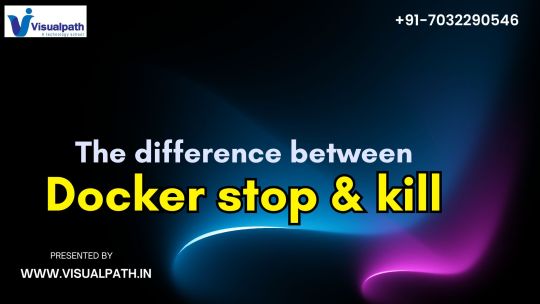
Understanding docker stop
The docker stop command is used to gracefully stop a running container. When executed, Docker sends a SIGTERM signal to the main process inside the container. This signal allows the application inside the container to perform necessary cleanup tasks, such as closing database connections, saving state information, or finishing any ongoing processes. If the container does not stop within a specified timeout period, Docker then sends a SIGKILL signal to forcefully terminate it. Docker and Kubernetes Online Training
Key Characteristics of docker stop
Sends a SIGTERM signal first, giving the container time to exit gracefully.
Waits for a default timeout period (10 seconds) before forcefully stopping the container.
Ensures that applications can complete ongoing processes and handle shutdown procedures.
Useful for stopping containers running databases, web servers, or applications that require a proper shutdown process.
When to Use docker stop?
When you want to gracefully shut down a container.
When running a service that requires cleanup before stopping.
When handling stateful applications like databases or message queues.
Understanding docker kill
The docker kill command is a more aggressive way to stop a container. Instead of allowing the application to terminate naturally, docker kill immediately sends a SIGKILL signal, which forces the container to stop without any cleanup. This means the application does not get a chance to release resources or save data before termination. Docker Kubernetes Online Course
Key Characteristics of docker kill
Immediately sends a SIGKILL signal, forcefully stopping the container.
Does not wait for any cleanup processes inside the container.
Can specify an alternative signal instead of SIGKILL using the --signal option.
Useful for quickly stopping unresponsive or misbehaving containers.
When to Use docker kill?
When a container is unresponsive and does not stop using docker stop.
When you need to immediately free up system resources.
When dealing with stuck or malfunctioning applications.
When performing automated testing where quick termination is required.
Major Differences Between docker stop and docker kill
The primary difference between docker stop and docker kill is how they terminate a running container. The docker stop command sends a SIGTERM signal first, allowing the container to shut down gracefully. If it does not stop within a specified timeout, Docker sends a SIGKILL signal to force termination. In contrast, docker kill immediately sends a SIGKILL signal, terminating the container without any cleanup. docker stop is ideal for preserving data integrity, while docker kill is used for unresponsive containers that need to be forcefully stopped. Choosing the right command depends on whether a graceful shutdown is required.
Best Practices for Stopping Docker Containers
Prefer docker stop over docker kill if the application inside the container needs to handle termination properly, always use docker stop first. Docker and Kubernetes Course
Ensure Applications Handle SIGTERM some applications may not handle SIGTERM correctly, leading to unexpected terminations. Configuring them to handle shutdown signals properly can prevent data corruption.
Use docker kill Only When Necessary if a container is unresponsive or stuck, docker kill is the best option. However, it should not be the default way to stop containers.
Adjust Timeout If needed The default timeout for docker stop is 10 seconds. If an application needs more time to shut down, you can specify a custom timeout using:
Php-template
CopyEdit
docker stop -t <seconds> <container_id>
Monitor Container Logs If a container takes too long to stop, check its logs using docker logs to identify issues. Docker and Kubernetes Training
Conclusion
The primary difference between docker stop and docker kill lies in how they terminate containers. The docker stop command gracefully shuts down a container by sending a SIGTERM signal first, ensuring that the application has time to clean up. In contrast, docker kill immediately terminates a container using a SIGKILL signal, without any cleanup.
For most situations, docker stop is the preferred method because it allows for safe termination. However, if a container becomes unresponsive or needs to be forcefully stopped, docker kill is the better option.
Trending Courses: ServiceNow, SAP Ariba, Site Reliability Engineering
Visualpath is the Best Software Online Training Institute in Hyderabad. Avail is complete worldwide. You will get the best course at an affordable cost. For More Information about Docker and Kubernetes Online Training
Contact Call/WhatsApp: +91-7032290546
Visit: https://www.visualpath.in/online-docker-and-kubernetes-training.html
#DockerandKubernetesTraining#DockerandKubernetesCourse#DockerandKubernetesTraininginHyderabad#DockerKubernetesOnlineCourse#DockerOnlineTraining#KubernetesOnlineTraining#DockerandKubernetesOnlineTraining#KubernetesCertificationTrainingCourse#DockerandKubernetesTraininginAmeerpet#KubernetesOnlineTraininginIndia#DockerandKubernetesTraininginBangalore#DockerandKubernetesTraininginChennai
0 notes
Text

💡 "Upgrade Your Career with Ease: Master Docker & Kubernetes" Join our FREE DEMO to explore the possibilities.
🔗 JOIN link: https://bit.ly/4ioOoCU
👉 Meeting ID: 480 746 067 35
👉 Passcode: RF3Vr3zj
👉 Attend Online #FreeDemo from Visualpath on #DockerandKubernetes by 👨🏫Mr. Vihaan (Best Industry Expert).
📅 Demo on: 22/03/2025 @9AM IST
📲 Contact us: +91 7032290546
🌐 Visit: https://www.visualpath.in/online-docker-and-kubernetes-training.html
👉 WhatsApp: https://wa.me/c/917032290546🌐 Visit Blog: https://dockerandkubernetestraining.blogspot.com/
#DockerandKubernetesTraining#DockerandKubernetesCourse#DockerandKubernetesTraininginHyderabad#DockerKubernetesOnlineCourse#DockerOnlineTraining#KubernetesOnlineTraining#DockerandKubernetesOnlineTraining#KubernetesCertificationTrainingCourse#DockerandKubernetesTraininginAmeerpet#KubernetesOnlineTraininginIndia#DockerandKubernetesTraininginBangalore#DockerandKubernetesTraininginChennai
0 notes
Text
Docker Kubernetes | Docker and Kubernetes Online Training
Running Containers with Docker & Kubernetes
In the Docker and Kubernetes cloud-native world, containerization has revolutionized application deployment and management. Docker and Kubernetes are the two most widely used technologies for running and orchestrating containers. While Docker simplifies container creation and deployment, Kubernetes ensures efficient container management at scale. This article explores the key concepts, benefits, and use cases of running containers with Docker and Kubernetes.
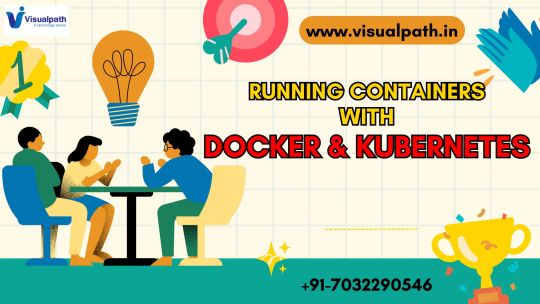
Understanding Containers
A container is a lightweight, standalone package that includes everything needed to run an application, including the code, runtime, libraries, and dependencies. Unlike traditional virtual machines (VMs), containers share the host operating system’s kernel, making them more efficient, portable, and faster to start. Docker and Kubernetes Online Training
Key benefits of containers:
Portability: Containers run the same way across different environments, from a developer’s laptop to cloud servers.
Scalability: Containers can be quickly replicated and distributed across multiple nodes.
Resource Efficiency: Since containers share the host OS, they consume fewer resources than VMs.
What is Docker?
Docker is an open-source platform that allows developers to build, package, and distribute applications as containers. It provides a simple way to create containerized applications using a Dockerfile, which defines the container’s configuration.
Key features of Docker:
Containerization: Encapsulates applications with their dependencies.
Image-based Deployment: Applications are deployed using lightweight, reusable container images.
Simplified Development Workflow: Developers can build and test applications in isolated environments. Docker Kubernetes Online Course
Docker is ideal for small-scale deployments but has limitations in managing large containerized applications across multiple servers. This is where Kubernetes comes in.
What is Kubernetes?
Kubernetes (often abbreviated as K8s) is an open-source container orchestration platform designed to automate the deployment, scaling, and management of containerized applications. Originally developed by Google, Kubernetes is now widely used for running container workloads at scale.
Key components of Kubernetes:
Pods: The smallest deployable unit that contains one or more containers.
Nodes: The physical or virtual machines that run container workloads.
Clusters: A group of nodes working together to run applications.
Services: Help manage network communication between different components of an application.
How Docker and Kubernetes Work Together
While Docker is used to create and run containers, Kubernetes is responsible for managing them in production. Here’s how they work together: Docker and Kubernetes Course
Building a Container: A developer packages an application as a Docker container.
Pushing the Image: The container image is stored in a container registry like Docker Hub.
Deploying with Kubernetes: Kubernetes pulls the container image and deploys it across multiple nodes.
Scaling & Load Balancing: Kubernetes automatically scales the application based on demand.
Monitoring & Recovery: If a container crashes, Kubernetes restarts it automatically.
This combination ensures high availability, scalability, and efficient resource utilization.
Benefits of Using Docker & Kubernetes Together
Scalability: Kubernetes allows dynamic scaling of applications based on traffic.
Fault Tolerance: Kubernetes automatically replaces failed containers to maintain uptime.
Automation reduces manual intervention by automating deployments and updates.
Multi-Cloud Compatibility: Works across different cloud providers like AWS, Azure, and Google Cloud.
Use Cases of Docker & Kubernetes
Microservices Deployment: Ideal for running and managing microservices-based applications.
CI/CD Pipelines: Streamlines application development with automated testing and deployment.
Hybrid Cloud Deployments: Enable running applications across on-premises and cloud environments.
Big Data Processing: Supports large-scale data workloads using containerized environments. Docker and Kubernetes Training
Conclusion
Docker and Kubernetes have transformed modern application deployment by making it faster, more scalable, and highly efficient. While Docker simplifies containerization, Kubernetes takes it a step further by providing automation, scaling, and self-healing capabilities. Together, they form a powerful combination for building and managing cloud-native applications.
Trending Courses: ServiceNow, SAP Ariba, Site Reliability Engineering
Visualpath is the Best Software Online Training Institute in Hyderabad. Avail is complete worldwide. You will get the best course at an affordable cost. For More Information about Docker and Kubernetes Online Training
Contact Call/WhatsApp: +91-7032290546
Visit: https://www.visualpath.in/online-docker-and-kubernetes-training.html
#DockerandKubernetesTraining#DockerandKubernetesCourse#DockerandKubernetesTraininginHyderabad#DockerKubernetesOnlineCourse#DockerOnlineTraining#KubernetesOnlineTraining#DockerandKubernetesOnlineTraining#KubernetesCertificationTrainingCourse#DockerandKubernetesTraininginAmeerpet#KubernetesOnlineTraininginIndia#DockerandKubernetesTraininginBangalore#DockerandKubernetesTraininginChennai
0 notes
Text
Docker and Kubernetes Training in Bangalore | Docker and Kubernetes
Kubernetes & Docker: Real-World Scenarios
Kubernetes and Docker have become essential tools for organizations looking to build, deploy, and scale applications efficiently. These technologies are widely used in real-world scenarios to handle complex applications, improve resource utilization, and provide seamless deployment. In this article, we will explore the most common real-world use cases where Kubernetes and Docker shine together.
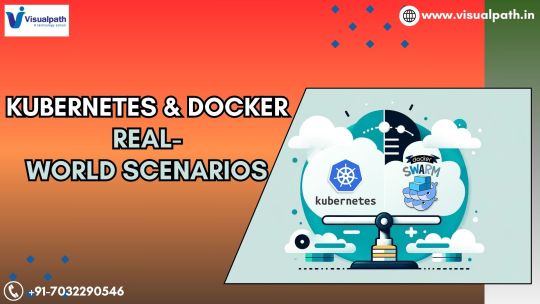
Microservices Architecture Deployment
One of the most popular real-world applications of Kubernetes and Docker is in deploying microservices-based applications. Microservices break down large applications into smaller, independent services. Each service can be packaged into a Docker container, making it portable and easy to manage. Docker and Kubernetes Training
Kubernetes orchestrates these containers across multiple servers, ensuring that they stay running, scale when necessary, and recover from failures. This approach is widely adopted by companies like Netflix, Amazon, and Uber to ensure smooth, large-scale operations with high availability.
Example: Imagine an e-commerce website where the payment service, user authentication, and product catalog are all separate microservices. Each service runs in its own Docker container, and Kubernetes manages the entire cluster, ensuring each microservice scales during high-traffic events like Black Friday.
Automated CI/CD Pipelines
In real-world DevOps environments, integrating Kubernetes and Docker into Continuous Integration and Continuous Deployment (CI/CD) pipelines helps teams deliver code faster and more reliably. Docker Online Training
With Docker, developers can build and test their applications in isolated environments. Once the code passes all checks, Kubernetes can handle automated deployments to production clusters without downtime.
Example: A fintech company can build a CI/CD pipeline where every time a developer pushes new code, a Docker image is created, tested, and automatically deployed using Kubernetes. Rollbacks are easy, and updates are seamless, reducing human error.
Handling Traffic Spikes
Businesses often experience sudden traffic spikes, such as during holiday sales or viral social media moments. With Docker and Kubernetes, scaling applications to handle increased loads becomes simple and automated.
Kubernetes automatically monitors the system's load and scales containers horizontally (by adding more container instances) to manage high demand. Once the traffic decreases, it scales down the containers to save resources.
Example: Streaming platforms like Spotify or YouTube rely on Kubernetes and Docker to scale their services dynamically, ensuring millions of users get a smooth experience during peak hours
Hybrid and Multi-Cloud Deployments
Many organizations are shifting towards hybrid cloud or multi-cloud strategies to avoid vendor lock-in and improve redundancy. Docker and Kubernetes play a critical role in these deployments by offering consistent environments across different cloud providers. Kubernetes Online Training
Example: A global enterprise can deploy part of its workload on AWS and another part on Google Cloud using Kubernetes clusters. Docker containers ensure that the application behaves the same regardless of where it runs, improving portability and reliability.
Edge Computing and IoT
In edge computing and IoT (Internet of Things) scenarios, deploying services closer to the source of data is crucial for reducing latency. Docker containers provide lightweight environments ideal for edge devices, while Kubernetes helps manage deployments across distributed locations.
Example: Smart cities use Docker and Kubernetes to manage traffic systems, sensors, and public safety systems in real time, with workloads running at the edge and managed centrally. Docker and Kubernetes Online Training
Conclusion
Real-world use cases of Kubernetes and Docker highlight why these tools have become the backbone of modern application deployment. From handling microservices and automating CI/CD pipelines to managing traffic spikes and supporting hybrid cloud strategies, they provide reliable, scalable, and efficient solutions for businesses of all sizes. By leveraging Kubernetes and Docker together, organizations can ensure their applications are resilient, portable, and ready to meet today’s growing demands.
Visualpath is the Best Software Online Training Institute in Hyderabad. Avail is complete worldwide. You will get the best course at an affordable cost. For More Information about Docker and Kubernetes Training
Contact Call/WhatsApp: +91-9989971070
Visit: https://www.visualpath.in/online-docker-and-kubernetes-training.html
#DockerandKubernetesTraining#DockerandKubernetesCourse#DockerandKubernetesTraininginHyderabad#DockerKubernetesOnlineCourse#DockerOnlineTraining#KubernetesOnlineTraining#DockerandKubernetesOnlineTraining#KubernetesCertificationTrainingCourse#DockerandKubernetesTraininginAmeerpet#KubernetesOnlineTraininginIndia#DockerandKubernetesTraininginBangalore#DockerandKubernetesTraininginChennai
0 notes
Text
Docker and Kubernetes Online Training in India | Visualpath
Docker and Kubernetes: CI/CD Pipelines
Continuous Integration and Continuous Deployment (CI/CD) have become essential for modern software development. Docker and Kubernetes are two critical technologies that help streamline and automate CI/CD pipelines, ensuring faster and more reliable application deployment. This article explores how Docker and Kubernetes contribute to CI/CD pipelines, their benefits, and the best practices for implementation.
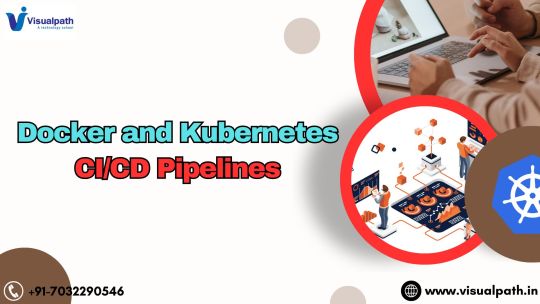
Understanding CI/CD Pipelinesis
CI/CD pipelines automate software delivery by integrating code changes frequently and deploying them efficiently. They consist of the following key stages: Docker and Kubernetes Training
Continuous Integration (CI): Developers merge their code into a shared repository multiple times a day. Automated tests are run to detect errors early.
Continuous Deployment (CD): Once the code passes all tests, it is automatically deployed to a staging or production environment.
Continuous Delivery (CD): Ensures every code change is deployable at any time, even if deployment is not fully automated.
Role of Docker in CI/CD Pipelines
Docker simplifies CI/CD pipelines by packaging applications and their dependencies into containers. This ensures consistency across different environments. Here’s how Docker enhances CI/CD:
Consistency Across Environments: Developers can create Docker images that work the same way on local, testing, and production environments.
Fast and Reliable Builds: Docker allows applications to be built once and run anywhere, reducing build time and minimizing compatibility issues.
Scalability: Docker containers can be quickly scaled up or down as needed.
Steps to Use Docker in CI/CD Pipelines
Build Docker Images: Use a Dockerfile to define application dependencies and configurations.
Push to a Container Registry: Store the image in a registry like Docker Hub or Azure Container Registry.
Deploy Using Orchestration: Kubernetes or another container orchestration tool can pull and run the images. Docker and Kubernetes Course
Role of Kubernetes in CI/CD Pipelines
Kubernetes automates container deployment, scaling, and management. It ensures smooth application delivery in CI/CD pipelines through:
Automated Rollouts and Rollbacks: Kubernetes manages deployments with rolling updates and can revert to previous versions if issues arise.
Load Balancing: Ensures traffic is distributed efficiently across containers.
Self-Healing: Automatically replaces failed containers to maintain uptime.
Declarative Configuration: Kubernetes uses YAML manifests for predictable and repeatable deployments.
Implementing Kubernetes in a CI/CD Pipeline
Use Kubernetes Manifests: Define Deployment, Service, and Ingress configurations in YAML files.
Automate Deployments: Utilize tools like Helm or Kustomize for Kubernetes resource management.
Integrate with CI/CD Tools: Jenkins, GitHub Actions, GitLab CI/CD, or Azure DevOps can trigger deployments based on code changes. Docker and Kubernetes Online Training
CI/CD Pipeline Workflow with Docker and Kubernetes
Code Commit: A developer pushes code to a version control system (e.g., GitHub, GitLab).
CI Process: A CI tool builds the Docker image, runs tests, and pushes the image to a container registry.
CD Process: Kubernetes pulls the latest image and updates the running application.
Monitoring & Logging: Tools like Prometheus and Grafana monitor deployments, while logging solutions like ELK Stack provide insights.
Best Practices for Docker and Kubernetes in CI/CD
Use Multi-Stage Docker Builds: This reduces image size and improves performance.
Scan Docker Images for Security Vulnerabilities: Use tools like Trivy or Clair.
Implement Rolling Updates in Kubernetes: Avoid downtime during deployments.
Leverage Infrastructure as Code (IaC): Use Terraform or Kubernetes manifests for consistent deployments.
Automate Everything: From testing to deployment, automation ensures efficiency and reliability.
Conclusion
Docker and Kubernetes revolutionize CI/CD pipelines by automating deployment, ensuring consistency, and improving scalability. By leveraging containerization and orchestration, organizations can achieve faster releases, higher reliability, and improved software quality. Implementing best practices ensures smooth and secure CI/CD workflows.
Visualpath is the Best Software Online Training Institute in Hyderabad. Avail complete worldwide. You will get the best course at an affordable cost. For More Information about Docker and Kubernetes Training
Contact Call/WhatsApp: +91-9989971070
Visit: https://www.visualpath.in/online-docker-and-kubernetes-training.html
#DockerandKubernetesTraining#DockerandKubernetesCourse#DockerandKubernetesTraininginHyderabad#DockerKubernetesOnlineCourse#DockerOnlineTraining#KubernetesOnlineTraining#DockerandKubernetesOnlineTraining#KubernetesCertificationTrainingCourse#DockerandKubernetesTraininginAmeerpet#KubernetesOnlineTraininginIndia#DockerandKubernetesTraininginBangalore#DockerandKubernetesTraininginChennai
0 notes
Text
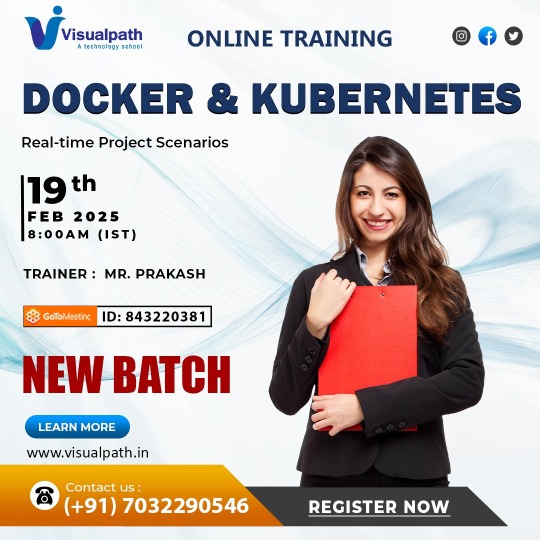
"Deploy Smarter, Scale Faster with Docker and Kubernetes." Join our NEW BATCH to explore the possibilities.
Join Now: https://meet.goto.com/843220381
Attend Online #NewBatch from Visualpath on #DockerandKubernetes by Mr. Prakash (Best Industry Expert).
Batch ON: 19/02/2025 @8AM IST
Contact us: +91 7032290546
Visit: https://www.visualpath.in/online-docker-and-kubernetes-training.html
WhatsApp: https://www.whatsapp.com/catalog/919989971070/Visit Blog: https://dockerandkubernetestraining.blogspot.com/
#DockerandKubernetesTraining#DockerandKubernetesCourse#DockerandKubernetesTraininginHyderabad#DockerKubernetesOnlineCourse#DockerOnlineTraining#KubernetesOnlineTraining#DockerandKubernetesOnlineTraining#KubernetesCertificationTrainingCourse#DockerandKubernetesTraininginAmeerpet#KubernetesOnlineTraininginIndia#DockerandKubernetesTraininginBangalore#DockerandKubernetesTraininginChennai
0 notes
Text
Kubernetes Online Training in India | Visualpath
How to Use Docker & Kubernetes for Developers Docker and Kubernetes have become essential tools for modern developers. They simplify the process of building, managing, and deploying applications. Understanding how to use Docker and Kubernetes can help developers streamline their workflows and improve efficiency. In this article, we will explore how these tools work together and their benefits for developers.
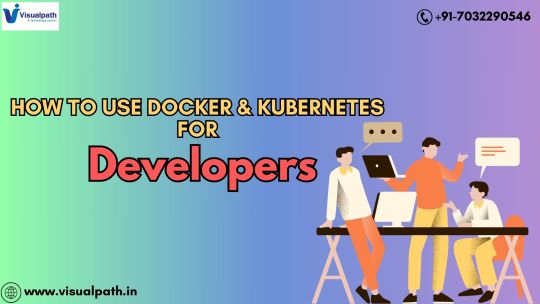
What is Docker?
Docker is a platform that allows developers to create, package, and run applications in containers. Containers are lightweight and include everything needed to run an application, such as code, libraries, and dependencies. This ensures that applications work consistently across different environments. Docker and Kubernetes Training
Benefits of Docker for Developers:
Easy to Use: Developers can package their applications with all dependencies into a single container.
Portability: Containers run consistently on any platform, from a developer’s laptop to the cloud.
Faster Development: Docker speeds up the development process by providing pre-built images.
Version Control: Docker allows developers to manage versions of their applications easily.
What is Kubernetes?
Kubernetes is a system that helps manage, scale, and deploy containerized applications. It automates many tasks, such as load balancing, scaling, and restarting failed containers.
Benefits of Kubernetes for Developers:
Automated Management: Kubernetes handles the deployment and scaling of applications automatically.
High Availability: Distributing traffic across containers ensures that applications remain available.
Scalability: Developers can scale their applications easily without downtime.
Resource Efficiency: Kubernetes optimizes the use of computing resources.
Using Docker and Kubernetes Together
Docker and Kubernetes work together to simplify the development and deployment process. Docker is used to create and package applications, while Kubernetes is used to manage and scale them. Here is how developers benefit from using both:
Consistent Environment: Developers can use Docker to build containers that run the same way in any environment. Kubernetes then deploys and manages these containers efficiently. Docker and Kubernetes Course
Faster Collaboration: Teams can share Docker images, ensuring that everyone is working with the same setup.
Easy Scaling: Kubernetes scales Docker containers automatically based on traffic and demand.
Improved Deployment: Developers can update applications without downtime using Kubernetes rolling updates.
Best Practices for Developers
Use Lightweight Docker Images: Smaller images reduce build times and use fewer resources.
Label Docker Containers Properly: This helps with organization and management.
Configure Kubernetes Properly: Use namespaces to manage multiple projects.
Monitor Performance: Use Kubernetes tools to monitor container health.
Secure Applications: Limit access to sensitive data within containers.
Why Developers Should Use Docker and Kubernetes
Efficiency: Docker containers start quickly and use fewer resources.
Portability: Applications run the same in development, testing, and production.
Scalability: Kubernetes handles increased traffic without manual intervention.
Automation: Kubernetes automates deployment, scaling, and recovery.
Flexibility: Developers can use Docker and Kubernetes with various programming languages and frameworks. Docker and Kubernetes Online Training
Conclusion
Docker and Kubernetes are powerful tools that help developers build, manage, and deploy applications more efficiently. Docker simplifies the creation of consistent development environments, while Kubernetes automates deployment and scaling. By using these tools together, developers can improve productivity and deliver reliable applications. Understanding and implementing Docker and Kubernetes in your workflow will enhance your development skills and ensure successful project delivery.
Visualpath is the Best Software Online Training Institute in Hyderabad. Avail complete worldwide. You will get the best course at an affordable cost. For More Information about Docker and Kubernetes Training
Contact Call/WhatsApp: +91-9989971070
Visit: https://www.visualpath.in/online-docker-and-kubernetes-training.html
#DockerandKubernetesTraining#DockerandKubernetesCourse#DockerandKubernetesTraininginHyderabad#DockerKubernetesOnlineCourse#DockerOnlineTraining#KubernetesOnlineTraining#DockerandKubernetesOnlineTraining#KubernetesCertificationTrainingCourse#DockerandKubernetesTraininginAmeerpet#KubernetesOnlineTraininginIndia#DockerandKubernetesTraininginBangalore#DockerandKubernetesTraininginChennai
0 notes
Text
Docker Kubernetes | Docker Kubernetes Training in Chennai
The concept of Docker Networking and its types
Docker networking is a crucial aspect of containerized environments, enabling communication between containers, the host machine, and external networks. It ensures seamless data exchange, efficient resource utilization, and secure communication. Understanding Docker networking is essential for deploying scalable and interconnected applications.

Understanding Docker Networking
Docker networking provides a way for containers to communicate with each other and external services. By default, every Docker container is assigned an IP address, allowing it to interact with other containers or the host system. Docker uses a networking stack to manage different network configurations, providing flexibility based on application needs.
Docker networking is essential for microservices architecture, where different services run in separate containers but need to communicate efficiently. It helps in isolating applications, securing data transmission, and optimizing network performance. Docker Online Training
Types of Docker Networking
Docker offers several network types, each serving different purposes. The main types include Bridge NetwoNetworksrk, Host Network, None Network, Overlay Network, and Macvlan Network.
1. Bridge Network
The bridge network is the default network type created by Docker when a container starts. It allows containers on the same host to communicate with each other while isolating them from external networks. The bridge network works as a virtual switch that connects multiple containers on a single host.
Use Case:
Best suited for standalone container applications running on a single host.
Used when containers need to communicate internally but should remain isolated from external access unless explicitly exposed.
2. Host Network
In the host network, the container shares the host machine’s networking stack instead of creating its own. This means the container does not get a separate IP address but uses the host’s IP and ports directly. This eliminates network overhead but reduces isolation.
Use Case:
Useful for applications requiring low latency and direct network access.
Suitable for performance-intensive applications that need to avoid NAT (Network Address Translation). Docker Kubernetes Online Course
Ideal when a containerized application must bind to a specific port on the host.
3. None Network
The non-work network disables networking for a container, ensuring complete isolation. The container does not receive an IP address and cannot communicate with other containers or the external world.
Use Case:
Used when a container does not require networking, such as background processing or batch jobs.
Ideal for security-sensitive applications that should not have any network access.
4. Overlay Network
Overlay networks are used in Docker Swarm mode for multi-host networking. It enables communication between containers running on different Docker hosts by creating a distributed virtual network across multiple machines. This network type is essential for orchestrating microservices across a cluster.
Use Case:
Suitable for multi-host Docker deployments.
Essential for running microservices in a clustered environment.
Helps in seamless communication between containers across different physical or virtual machines. Docker and Kubernetes Course
5. Macvlan Network
The Macvlan network assigns a unique MAC address to each container, making it appear as a physical device on the network. It allows containers to communicate directly with external networks without NAT, making them behave like independent network devices.
Use Case:
Best for legacy applications that require a specific MAC address.
Ideal when containers need to be directly accessible on the physical network without port mapping.
Useful for network administrators who want better control over traffic routing and security policies.
Choosing the Right Docker Network
Selecting the right Docker network type depends on the application’s requirements:
Use Bridge Network when running containers on a single host that need internal communication but should remain isolated.
Use the Host Network for performance-intensive applications needing direct access to the host network.
Use None Network when a container does not require any network access.
Use Overlay Network for multi-host communication in a Docker Swarm cluster.
Use Macvlan Network for direct network access with unique MAC addresses.
Conclusion
Docker networking is crucial in managing containerized applications by enabling communication and ensuring security. By understanding the different network types—Bridge, Host, None, Overlay, and Macvlan—developers can optimize container networking based on their application needs. Properly configuring Docker networks enhances performance, scalability, and security, making it an essential aspect of container management.
Visualpath is the Best Software Online Training Institute in Hyderabad. Avail complete worldwide. You will get the best course at an affordable cost. For More Information about Docker Online Training
Contact Call/WhatsApp: +91-9989971070
Visit: https://www.visualpath.in/online-docker-and-kubernetes-training.html
#DockerandKubernetesTraining#DockerandKubernetesCourse#DockerandKubernetesTraininginHyderabad#DockerKubernetesOnlineCourse#DockerOnlineTraining#KubernetesOnlineTraining#DockerandKubernetesOnlineTraining#KubernetesCertificationTrainingCourse#DockerandKubernetesTraininginAmeerpet#KubernetesOnlineTraininginIndia#DockerandKubernetesTraininginBangalore#DockerandKubernetesTraininginChennai
0 notes
Text
Best Docker Kubernetes | Docker Kubernetes Online Course
Mastering of Docker & Kubernetes
Introduction
Docker and Kubernetes have revolutionized application deployment, making them essential skills for developers, DevOps engineers, and IT professionals. Docker simplifies containerization, allowing applications to run consistently across different environments. Kubernetes, on the other hand, automates the deployment, scaling, and management of containerized applications.
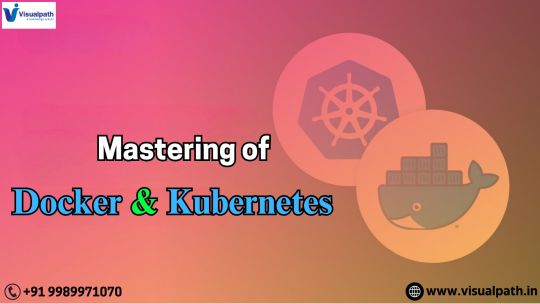
To master these technologies, you need a structured learning approach that includes foundational knowledge, hands-on practice, and real-world applications. This guide provides the best content sources and a step-by-step learning path to help you become proficient in Docker and Kubernetes. Docker Online Training
Step 1: Mastering Docker Fundamentals
Docker is the foundation of modern containerized applications. Before diving into Kubernetes, it's crucial to understand Docker’s core concepts.
Key Topics to Learn:
Understanding Containers vs. Virtual Machines
Installing Docker on Windows, macOS, and Linux
Docker Images & Containers (Creating, Running, and Managing)
Dockerfile & Image Building
Docker Networking & Volumes
Docker Compose for Multi-Container Applications
Best Learning Resources:
Docker Docs – The official Docker documentation provides a comprehensive learning experience.
Docker’s YouTube Channel – Hands-on tutorials and live coding sessions.
Udemy & Coursera Courses – Structured courses with real-world examples.
Play with Docker – An interactive online lab for practicing commands.
Pro Tip: Start by containerizing a simple application like a Node.js or Python app and experiment with Docker Compose to manage multiple containers.
Step 2: Learning Kubernetes Basics
Once you have a solid understanding of Docker, the next step is Kubernetes, which manages and orchestrates containers at scale.
Key Topics to Learn:
Kubernetes Architecture & Components (Pods, Nodes, Clusters, API Server)
Kubernetes Deployments & ReplicaSets
Services & Networking in Kubernetes
Persistent Storage & ConfigMaps
Helm Charts for Application Packaging
Autoscaling, Load Balancing, and Monitoring
Best Learning Resources:
Kubernetes Official Docs – The most reliable and detailed resource.
Kubernetes Academy by VMware – Free courses for beginners and professionals.
Kube Academy – Practical labs to get hands-on experience.
YouTube Channels (TechKube AcademyWorld with Nana, Kubernetes.io) – Easy-to-follow video tutorials. Kubernetes Online Training
Minikube & Kind – Tools to set up a local Kubernetes cluster for practice.
Pro Tip: Deploy a simple application on Kubernetes, gradually adding features like auto-scaling and monitoring.
Step 3: Hands-on Projects for Practical Experience
The best way to master Docker and Kubernetes is through hands-on projects.
Project Ideas:
Deploy a Multi-Container Web Application – Use Docker Compose and Kubernetes to deploy a frontend-backend database system.
Set Up a CI/CD Pipeline – Automate deployment using GitHub Actions, Jenkins, or GitLab CI/CD.
Manage Kubernetes with Helm – Package and deploy applications using Helm charts.
Monitor Kubernetes Clusters – Use Prometheus and Grafana to track cluster health and performance.
Secure Kubernetes Deployments – Implement Role-Based Access Control (RBAC) and network policies.
Best Platforms for Hands-on Practice:
Katacoda & Play with Kubernetes – Interactive environments without installation.
Google Kubernetes Engine (GKE), AWS EKS, Azure AKS – Cloud-based Kubernetes clusters.
Docker Hub & Kubernetes GitHub Projects – Explore open-source projects for learning.
Pro Tip: Document your projects on GitHub or a blog to showcase your expertise.
Step 4: Certification & Advanced Learning
Once you’re comfortable with Docker and Kubernetes, earning certifications can validate your skills and boost your career. Kubernetes Certification Training Course
Best Certifications:
Docker Certified Associate (DCA) – Validates Docker fundamentals.
Certified Kubernetes Administrator (CKA) – Focuses on Kubernetes cluster management.
Certified Kubernetes Application Developer (CKAD) – Ideal for developers deploying applications on Kubernetes.
Certified Kubernetes Security Specialist (CKS) – Advanced security practices for Kubernetes.
Best Resources for Certification Prep:
Linux Foundation Training – Official Kubernetes certification courses.
KodeKloud & A Cloud Guru – Hands-on labs and practice tests.
Exam Simulators (Killer.sh) – Real-world certification practice environments.
Pro Tip: Follow exam guides and practice in real Kubernetes clusters before attempting certifications.
Conclusion
Mastering Docker and Kubernetes requires a combination of theoretical knowledge and hands-on experience. Start by understanding Docker’s fundamentals, then progress to Kubernetes for container orchestration. Utilize the best learning resources, practice real-world projects, and work towards certifications to solidify your expertise. Docker Kubernetes Online Course
By following this structured learning path, you’ll be well-equipped to manage containerized applications efficiently and advance your career in cloud computing and DevOps.
Visualpath is the Best Software Online Training Institute in Hyderabad. Avail complete worldwide. You will get the best course at an affordable cost. For More Information about Docker and Kubernetes Training
Contact Call/WhatsApp: +91-9989971070
Visit: https://www.visualpath.in/online-docker-and-kubernetes-training.html
#DockerandKubernetesTraining#DockerandKubernetesCourse#DockerandKubernetesTraininginHyderabad#DockerKubernetesOnlineCourse#DockerOnlineTraining#KubernetesOnlineTraining#DockerandKubernetesOnlineTraining#KubernetesCertificationTrainingCourse#DockerandKubernetesTraininginAmeerpet#KubernetesOnlineTraininginIndia#DockerandKubernetesTraininginBangalore#DockerandKubernetesTraininginChennai
0 notes